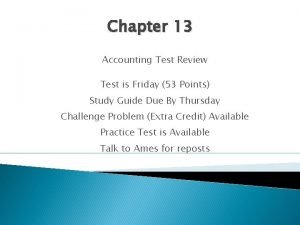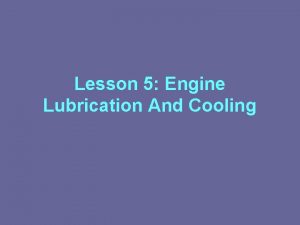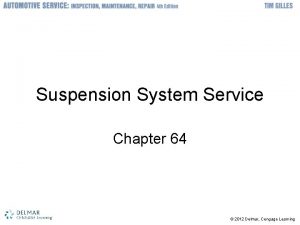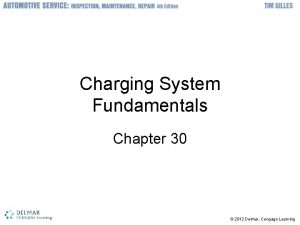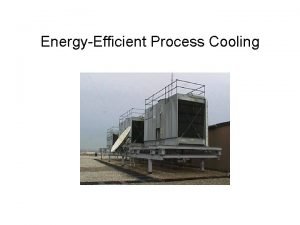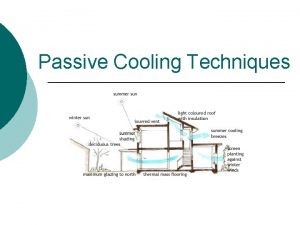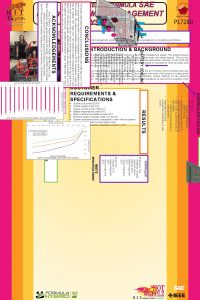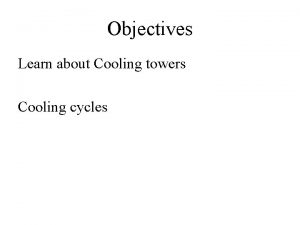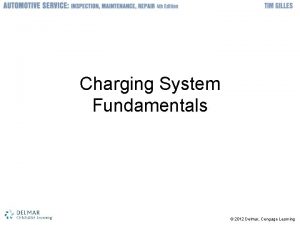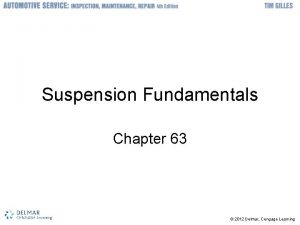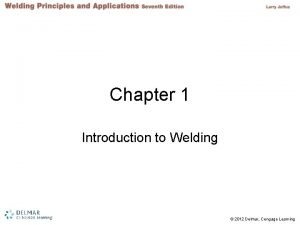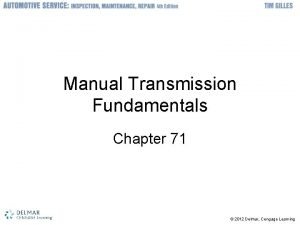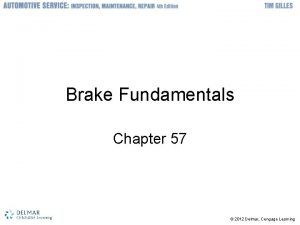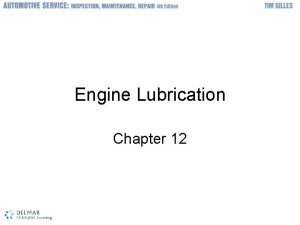Cooling System Service Chapter 21 2012 Delmar Cengage























- Slides: 23

Cooling System Service Chapter 21 © 2012 Delmar, Cengage Learning

Objectives • Diagnose cooling system problems • Service all parts of the cooling system © 2012 Delmar, Cengage Learning

Introduction • Cooling systems are dependable – Require periodic maintenance • Coolant system service – Best value in terms of preventative maintenance • Working on cooling systems is not difficult – Sometimes very profitable © 2012 Delmar, Cengage Learning

Diagnosing Cooling System Problems • Causes of cooling system problems: – Coolant level – Restricted radiator – Stuck thermostat – Defective water pump – Fan shroud – Frozen coolant – Defective cooling fan – Exhaust blockage – Inoperative EGR valve © 2012 Delmar, Cengage Learning

© 2012 Delmar, Cengage Learning

Radiator Cap • Damaged cap allows pressure to escape – Boiling point may drop causing boil over – Pressure tester tests the cap’s pressure valve • Radiator inspection – Inspect for leaks, damage, and obstructions • Coolant should fill entire radiator opening as it flows • Check condition of fins by rubbing gently • Broken engine mount can cause excessive movement • Leaks from heat exchanger cause transmission fluid to be pumped into radiator © 2012 Delmar, Cengage Learning

Coolant Service • Coolant loses protective ability and becomes corrosive – Check cold coolant for grease, dirt, rust, and corrosion bloom – Electrolysis makes small holes in parts • Cooling conductivity is checked with voltmeter • Voltmeter reading should be less than 0. 4 • Also caused by poor electrical conductivity in ground circuit – Coolant should be changed every 30, 000 miles – Most radiators have plastic drain valves © 2012 Delmar, Cengage Learning

Coolant Service (cont'd. ) • Special tools are used to separate a stuck hose from the radiator • Flush the system – Dirt and minerals build up in water jackets © 2012 Delmar, Cengage Learning

Coolant Service (cont'd. ) • Airlift leak check and airlock purge – Venturi system: uses compressed air to create a vacuum in the cooling system • Effective way to check for leaks and refill the cooling system © 2012 Delmar, Cengage Learning

Coolant Service (cont'd. ) • Coolant exchanger: prevents spillage • Aluminum oxide: forms when coolant is over diluted © 2012 Delmar, Cengage Learning

Testing Coolant Condition and Strength • Coolant test strips – Test the condition of the coolant • Coolant alkalinity (p. H) – Coolant must continue to contain reserve alkalinity • Coolant density testers – Measure a coolant’s freeze point • Hydrometers and refractometers – Test coolant concentration • Several coolant types – Dex. Cool and HOAT coolant © 2012 Delmar, Cengage Learning

Thermostat Service • Test in the vehicle – Hand-held multimeter or putting it into coolant • Thermostat check after removal – Lower into hot water with a thermometer • Good thermostats: fully closed when cold and fully open near its rating – When removing: drain until level is below thermostat housing first – When replacing: be sure thermostat fits into the groove in the block or outlet housing • Bleed air from the system to prevent overheating © 2012 Delmar, Cengage Learning

Locating Leaks • Locate leaks before starting a repair – Pressure tester identifies internal or external leaks – Test engine at different temperatures © 2012 Delmar, Cengage Learning

External Leaks • Check for external leaks: – Heater core and hoses – Radiator hoses – Thermostat housing and core plugs – Radiator and coolant pump • Core plug inspection – Common: rust and leakage • Coolant outlet (thermostat) housing inspection – Inspect for leaks or damage © 2012 Delmar, Cengage Learning

Internal Leaks • Bubble test – Look for bubbles in radiator when engine is warm • Hydrostatic lock – Engine stops with a piston down with valves closed and crankshaft will not turn • Block check test – Samples air in the radiator filler neck – Carbon monoxide changes the color of the tester • Infrared analyzer – Checks for exhaust gas in the coolant © 2012 Delmar, Cengage Learning

Recovery Tank Service • Most cooling systems have a plastic coolant reservoir or recovery tank – Recycles the coolant – Helps decrease corrosion • During a cooling system flush – Recovery tank or auxiliary reservoir is flushed of contaminants © 2012 Delmar, Cengage Learning

Cooling System Repairs • Replacing core plugs – Pound it sideways with a blunt drift punch – Do not leave an old core plug inside the block • Core plug installation – Clean the block opening with an emery cloth – Apply sealer to sides of new plug – Pound in with a driver or socket that fits loosely into the inside diameter of plug © 2012 Delmar, Cengage Learning

Water Pump Service • Coolant pump leakage: visible from vent hole • Worn bearing: use a stethoscope to listen for bad bearing • Worn or broken impeller: indicated with water pump action in radiator of warm, running engine • Water pump replacement: before installing, remove all fasteners – Inspect the old pump, select a new one, install, and refill © 2012 Delmar, Cengage Learning

Fan Inspection • Out-of-balance fan assembly leads to cooling pump shaft and bearing failure • Possible sources of pump failure – Leaking fan clutch – Bent or broken fan – Cocked or cracked aluminum fan spacer • Clean all mating surfaces and tighten fan bolts evenly to avoid cocked assembly • Fan clutch inspection – Fluid leaks and see if it is loose or frozen © 2012 Delmar, Cengage Learning

© 2012 Delmar, Cengage Learning

Electric Cooling Fan Service • Electric fans respond to signal from coolant temperature switch – Check for disconnected wire or burned out fuse • Inspection – Ohmmeter reads across the switch terminals • Should indicate infinite resistance – Wires connected: fan should engage when engine is warm – Wires disconnect: ohmmeter should indicate no connectivity © 2012 Delmar, Cengage Learning

Heater Core Service • Heater core – May leak or become plugged – Supplied with engine coolant through two hoses – Heat demands: controlled by doors to ducts around heater core • Hybrids cooling systems – Powered by electric motors that do not produce heat when the engine is shut off • Coolant system does not have to deal with heat load © 2012 Delmar, Cengage Learning

© 2012 Delmar, Cengage Learning
 Delmar cengage learning medical terminology
Delmar cengage learning medical terminology 2009 delmar cengage learning
2009 delmar cengage learning Challenge word building medical terminology
Challenge word building medical terminology Measuring and recording apical pulse
Measuring and recording apical pulse Chapter 6 the skeletal system answer key
Chapter 6 the skeletal system answer key 2009 delmar cengage learning
2009 delmar cengage learning Chapter 10 cultural diversity
Chapter 10 cultural diversity Delmar cengage learning instructor resources
Delmar cengage learning instructor resources 2012 cengage learning
2012 cengage learning Delmar isotonic
Delmar isotonic Delmar tsi
Delmar tsi Delmar international (thailand)
Delmar international (thailand) Delmar thomson learning
Delmar thomson learning Delmar larsen
Delmar larsen Pharyngorrhea
Pharyngorrhea Cengage chapter 7
Cengage chapter 7 Chapter 13 accounting study guide
Chapter 13 accounting study guide Copyright cengage learning. powered by cognero
Copyright cengage learning. powered by cognero Medical terminology chapter 5 learning exercises answers
Medical terminology chapter 5 learning exercises answers Cengage chapter 8 answers
Cengage chapter 8 answers Cengage chapter 5 medical terminology
Cengage chapter 5 medical terminology Matching muscle directions and positions
Matching muscle directions and positions Prescription terms
Prescription terms Lubrication of couling systems
Lubrication of couling systems
















